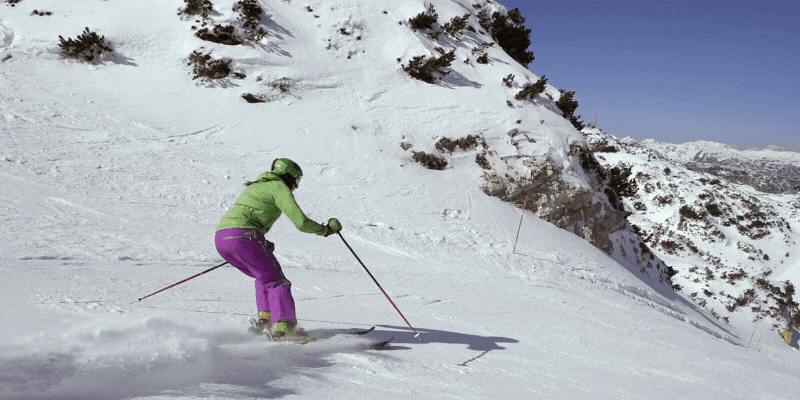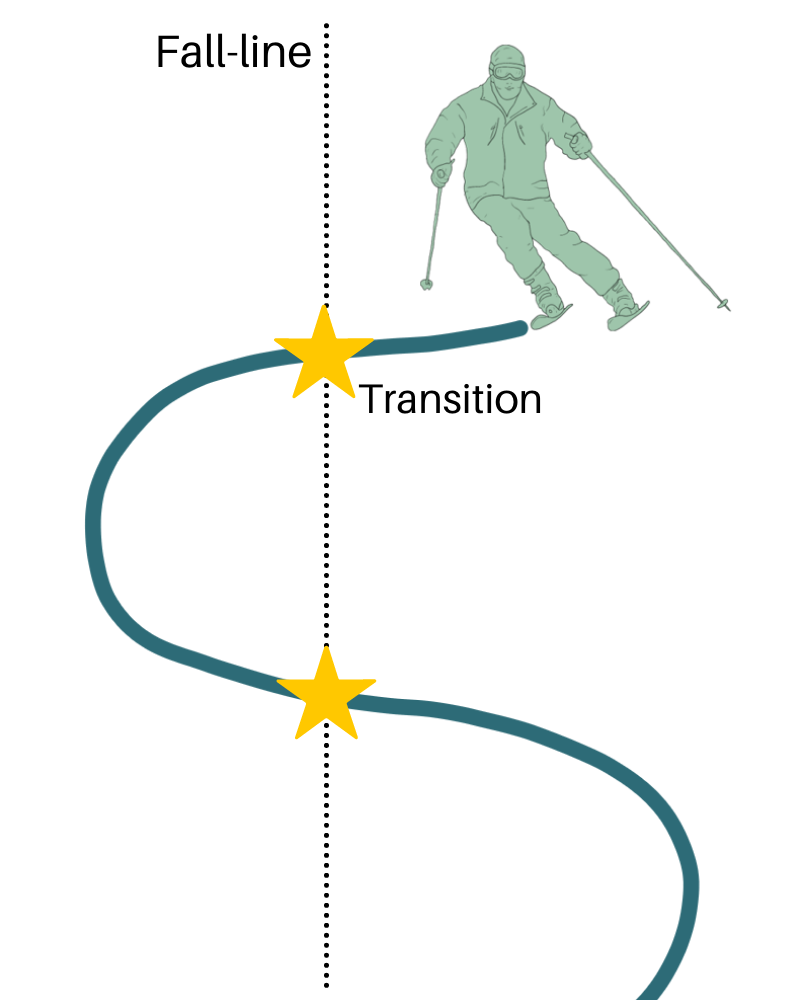Improve your turn transitions while skiing.

Turn transitions are an important part of skiing technique. As you move from one turn into another, the transition is the moment between the two turns. There are two key parts of a good turn transition: fully finishing one turn, and preparing to start the next turn.
Finishing a Turn
When you finish a turn, your skis should be facing across the hill. This allows your turns to have a nice “S” shape and is how turns let you control your speed.
- Spending more time with your skis facing across the hill will lead to a wider turn and a slower speed.
- Spending a shorter time with your skis facing across the hill between turns will lead to a more narrow turn and a faster speed.
The Moment of Transition
The moment in between one ski edge and the other ski edge, when your ski is flat, is the transition. During the transition, you should be light on your feet and more upright than at any other point in the turn. The transition is important for carving and generally fluid skiing. Improving your turn transitions can make your skiing a lot more fluid.
The transition is also when you transfer your weight from the outside ski of your last turn to what will be the outside ski of your next turn. Having smooth turn transitions is important for carving, and fluid skiing in general.

During your transition, you can also ease up on leaning forwards. Don’t let yourself get in the back seat, but you can ease up a bit to have a more balanced center of gravity.
For example, if you are coming out of a left turn, most of your weight should be on your right ski. As you end the left turn, your weight will briefly be evenly distributed between your two skis. Then, to begin the next right turn, you shift your weight onto your left ski, as your skis come onto their right edges.
Practicing smooth and complete turn transitions can help you improve your skiing overall, and help improve a lot of other aspects of good skiing technique.
Exercises to Practice Turn Transitions
Here are a couple of exercises you can practice to improve your turn transitions.
Touch the Sky
For this exercise, leave your poles on the rack, or hold them out in front of you perpendicular to the ground. While you are making your turn, hold your hands as usual– out in front of you with your shoulders extended slightly forwards, and elbows slightly bent.
After you finish one turn and before beginning the next one, raise your arms up to “touch the ski” and let your whole body stretch upwards to engage in this movement. Then, begin your next turn as your arms return to their normal position.
This exercise encourages you to spend time with a flat ski and to ease up the pressure on your skis between turns.
Jump on Transition
This exercise is a slightly more intense version of the touch the sky drill. After finishing a turn and right before beginning the next one, instead of raising your arms to “touch the sky,” do a little jump. This is a great way to make sure you are light on your feet between turns, and to warm yourself up on a cold day– this exercise will almost definitely have you sweating!
It is best to start out with this exercise on an easier intermediate trail, and then challenge yourself with steeper terrain once you have mastered it on the easier trails. The jump should not feel rushed. Take your time to fully finish the first turn, then do a nice relaxed jump, and then after landing smoothly, begin your next turn.
When landing your jump, use your knees to absorb your weight. Gently bending your knees upon landing the jump will lead you nicely into beginning the next turn. You should initiate and land your jump with your skis flat. Once you land, you can get on edge for your next turn.
This exercise forces you to have a transition period between your turns and to flatten your ski fully. It also forces you to think about your posture, as it is very difficult to do a jump while skiing if your posture is not good.
Be careful during this exercise. Try to maintain your form while jumping. Your upper body should remain facing down the hill while you are jumping. If you find that trying to jump between turns is distracting you too much from other parts of your form (like upper-lower body separation), switch to the touching the sky drill, and try jump transitions on easier/less steep terrain.
Final Thoughts On Turn Transitions
Turn transitions are an essential building block for good, controlled skiing. This article has focused on extended transitions, which is the most common transition in recreational skiing, and important to master before working on the more advanced technique of flexed transitions. Flexed transitions allow for even smoother, faster skiing and are typical for expert and high-performance skiing, including ski racing.
A flexed transition, or retraction, does not involve any rising up between turns. The skier remains low during the transition between turns, increasing the efficiency of a turn. To transition between turns, the skier will “shorten” their outside leg and simultaneously “lengthen” their inside leg.
This allows the skis to become unweighted without the skier rising up, and allows for faster turn transitions, as is necessary for ski racing.
To learn more about turn transitions, check out this YouTube video for a video analysis of some turn transitions, and more ways to improve!